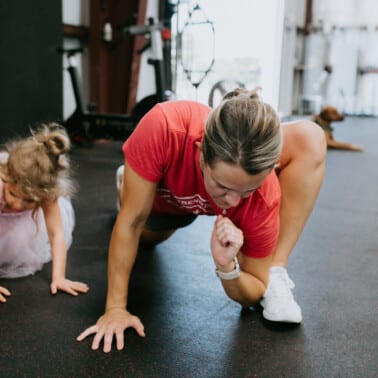Embarking on a fitness journey is an excellent way to improve your overall health and well-being. However, without proper precautions and knowledge, workouts can lead to injuries that may set you back and impede your progress. To ensure a safe and effective training experience, it’s crucial to implement certain strategies that prioritize injury prevention. Here we will explore some essential tips to help you avoid getting injured while working out.

Table of Contents
Read below for 7 ways to avoid getting injured when you work out. If you love this fitness article, be sure to check out these too: What is Functional Fitness?, The Importance of Strength Training for Women, and 9 Must-Haves for a Home Gym.
Seek Professional Guidance
Working with a qualified coach or personal trainer is invaluable when it comes to preventing workout injuries. A knowledgeable coach can guide you through proper form, technique, and exercise selection based on your fitness level and goals. They will design a tailored program that incorporates progressions and gradually increases intensity over time. By having a coach by your side, you gain expert guidance, accountability, and the peace of mind that you’re on the right track.
Start Slow and Gradually Progress
One of the most common mistakes individuals make when starting a workout routine is pushing too hard too soon. This aggressive approach can lead to overuse injuries, strains, or sprains. Instead, focus on starting slow and gradually increasing the intensity of your workouts. This allows your body to adapt and build strength while reducing the risk of injury. Begin with lighter weights, shorter durations, or lower intensities and gradually progress as your fitness level improves.
Emphasize Proper Form and Technique
Maintaining proper form and technique during exercises is crucial for injury prevention. Incorrect form not only reduces the effectiveness of the exercise but also increases the risk of strain or injury. When performing any movement, pay close attention to your body’s alignment, engage the appropriate muscles, and avoid jerky or uncontrolled movements. If you’re unsure about proper form, seek guidance from a professional or refer to reputable sources such as exercise tutorials from certified coaches.
Incorporate Full Range of Motion
To minimize the risk of muscle imbalances and joint issues, prioritize exercises that involve a full range of motion. Full range of motion exercises improve flexibility, joint stability, and overall muscle strength. Avoid cutting corners or shortening your range of motion to lift heavier weights. Instead, focus on executing each movement with control and through its entire range. If you’re struggling with mobility limitations, work on improving your flexibility gradually through targeted stretching exercises.
Implement Progressive Overload
Progressive overload is a fundamental principle in strength training that promotes continuous improvement while minimizing the risk of injury. It involves gradually increasing the intensity, volume, or duration of your workouts to challenge your muscles and stimulate growth. However, it’s crucial to implement progressive overload in a controlled and structured manner. Avoid sudden or excessive increases in weight, repetitions, or training frequency, as this can lead to overtraining and increased injury risk. Instead, aim for incremental changes and listen to your body’s feedback.
Listen to Your Body
Perhaps the most critical aspect of injury prevention is listening to your body. Pay attention to any warning signs such as pain, discomfort, or excessive fatigue. Pushing through pain or ignoring signs of overexertion can lead to severe injuries. If you experience persistent or worsening pain during or after a workout, it’s essential to take a break and seek medical advice if necessary. Rest and recovery are integral parts of any fitness program and should not be overlooked.
Balance Your Workout Routine
While it’s tempting to focus on specific muscle groups or exercises you enjoy, it’s essential to maintain a well-rounded workout routine. Incorporate exercises that target all major muscle groups, including cardiovascular activities and flexibility training. Neglecting certain areas of your body can lead to muscle imbalances and increased injury risk. By maintaining a balanced routine, you improve overall strength, endurance, and reduce the likelihood of overuse injuries.
Engaging in regular exercise offers numerous benefits for physical and mental well-being. However, it’s crucial to prioritize safety to prevent injuries that can hinder your progress. By following the strategies outlined in this article, such as working with a coach, starting slow, emphasizing proper form, incorporating full range of motion, implementing progressive overload, listening to your body, and maintaining a balanced routine, you can significantly reduce the risk of workout-related injuries. Remember, safety should always be a priority to ensure a long and fruitful fitness journey.
Fed and Fit Training Resources
I’ve been friends with the owners and trainers behind Elite Strength and Conditioning for over a decade, and we’ve come together to create four 30-day fitness programs for you:
- General Fitness Preparedness – also known as CrossFit workouts; encompasses strength and conditioning and is perfect for all fitness levels.
- Strength Training – functional strength and full-body muscle building.
- Bodyweight – high-intensity interval training (HIIT) program that can easily be done at home with minimal equipment.
- Mono-structural Aerobic Capacity – 30 minutes of endurance cardio programming for 30 days (can be added to any of the other programs).
Or get access to all of Elite’s full library of workouts via their digital app.















